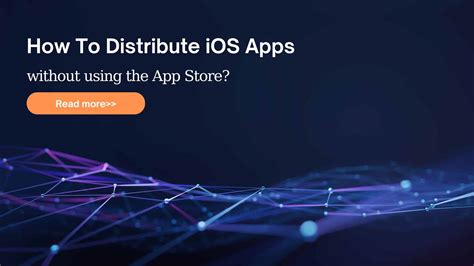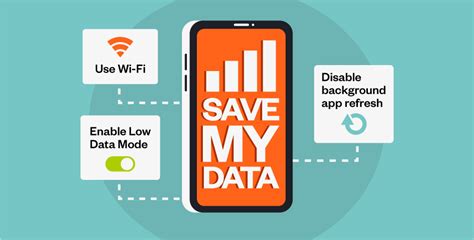In the fast-paced world of mobile app development, staying ahead of the curve is essential to deliver innovative and engaging experiences to users. Behind every successful iOS app lies a meticulous selection of advanced technologies and frameworks, harmoniously working together to create seamless interactions and stunning visual interfaces.
Leading developers have recognized that utilizing state-of-the-art tools and techniques is paramount to creating apps that captivate and impress users. From optimizing performance to providing an intuitive user interface, the adoption of the right technologies empowers developers to unlock the full potential of iOS app development.
In this article, we dive deep into the realm of iOS app development and explore the myriad of cutting-edge technologies that drive innovation in this ever-evolving field. From powerful programming languages to robust frameworks, we uncover the secrets behind the remarkable success of some of the most popular iOS applications on the market.
Swift Programming Language

The Swift programming language is a crucial component in the creation of iOS applications. With its robust and modern syntax, Swift offers developers a powerful tool for building innovative and feature-rich mobile apps.
Swift is known for its simplicity and readability, allowing developers to write clean and concise code. Its syntax is designed to be expressive, making it easier to understand and maintain. Additionally, Swift has a strong type system that helps catch errors and improve code quality.
One of the key features of Swift is its compatibility with Objective-C, allowing developers to seamlessly integrate legacy code into their new projects. This compatibility ensures that existing iOS libraries and frameworks can be easily leveraged by Swift developers.
Another important aspect of Swift is its safety features. The language includes built-in support for optionals, which helps avoid null pointer exceptions and improves overall code reliability. Additionally, Swift uses type inference to automatically infer the type of variables, reducing the chances of type-related errors.
When it comes to performance, Swift is designed to be fast. It leverages modern compiler technologies to optimize code execution, resulting in smooth and efficient app performance. With its focus on performance, Swift is able to deliver exceptional user experiences on iOS devices.
- Swift offers extensive support for key technologies used in iOS app development, such as Core Data, Grand Central Dispatch, and UIKit.
- It provides a wide range of built-in data types and collection classes, making it easier to handle data manipulation and management.
- Swift also introduces higher-order functions and closures, empowering developers to write more expressive and concise code.
- The language includes powerful error handling mechanisms, allowing developers to handle exceptions effectively and improve app stability.
In conclusion, Swift is a versatile and powerful programming language that plays a vital role in the development of iOS applications. Its simplicity, safety features, compatibility with Objective-C, and performance optimization make it a preferred choice for developers looking to create robust and high-performing mobile apps.
Xcode Integrated Development Environment
In the world of creating mobile applications for Apple devices, Xcode Integrated Development Environment (IDE) stands as an indispensable tool for developers. This section provides an overview of the significant role that Xcode plays throughout the app development process, emphasizing its importance in achieving successful outcomes.
Xcode IDE: Streamlining iOS App Development
As developers dive into creating innovative iOS applications, having a reliable and efficient integrated development environment is crucial. Xcode, equipped with a comprehensive set of tools, offers a seamless experience for developers to design, code, and debug their applications.
Facilitating App Design
Xcode provides a visual interface builder that simplifies the process of designing app interfaces. With an intuitive drag-and-drop interface, developers can easily create and arrange user interface components, defining the app's look and feel without having to write extensive code.
Efficient Coding with Swift
Integrating Swift, Apple's powerful and intuitive programming language, Xcode enables developers to write concise and expressive code. With features like autocomplete and syntax highlighting, Xcode assists developers in writing error-free code efficiently.
Streamlined Debugging and Testing
Effective debugging and testing are essential for ensuring the functionality and reliability of iOS applications. Xcode offers a range of debugging tools, including breakpoints, console logs, and performance analyzers, simplifying the process of identifying and fixing issues during the development cycle.
Seamless Deployment and Distribution
Once the development phase is complete, Xcode facilitates the deployment and distribution of iOS applications. Whether it's testing on physical devices, generating release builds, or submitting apps to the App Store, Xcode streamlines the entire process, ensuring a smooth transition from development to app release.
Conclusion
The Xcode Integrated Development Environment plays a vital role in the creation of iOS apps, offering a comprehensive set of tools that streamline app design, coding, debugging, and deployment processes. By providing a user-friendly interface, powerful programming language support, and efficient testing capabilities, Xcode empowers developers to bring their innovative ideas to life and deliver high-quality iOS applications to users worldwide.
App Store Connect for App Distribution

In this section, we will explore the platform that enables developers to distribute their applications to users through the App Store. App Store Connect serves as an essential tool for managing and distributing iOS applications, ensuring a seamless and efficient process.
1. Submission and Review Process:
- Submit your app for review: App Store Connect allows developers to submit their apps for review by Apple's App Review team. This process ensures that the application meets Apple's guidelines and standards for quality, security, and user experience.
- Review and feedback: During the review process, the App Review team thoroughly inspects the app, ensuring it complies with the guidelines. They may provide feedback or request modifications, which developers can address before resubmitting the app.
- App status updates: App Store Connect provides developers with real-time updates on the review status of their applications. This transparency allows developers to stay informed about the progress and estimated timeframes for approval.
2. App Distribution:
- Release management: With App Store Connect, developers can manage the release of their applications to specific regions, allowing for a controlled rollout strategy. They can schedule release dates, manage different versions of the app, and even roll back to previous versions if necessary.
- App metadata and assets: Developers can provide essential information about their applications, such as app descriptions, keywords, icons, and screenshots, through App Store Connect. This metadata helps users discover apps on the App Store.
- App Store Optimization (ASO): App Store Connect also provides tools for optimizing the visibility and discoverability of apps on the App Store. Developers can track and analyze user engagement, implement marketing campaigns, and respond to user reviews to improve their app's ranking and popularity.
- Testing and distribution options: App Store Connect offers various testing and distribution options, including beta testing through TestFlight. Developers can invite external testers to try their app and provide valuable feedback before its official release.
3. Analytics and Sales Data:
- App analytics: App Store Connect provides detailed analytics on how users interact with the app, including downloads, user engagement, in-app purchases, and more. These insights help developers make data-driven decisions to improve their app's performance and user experience.
- Sales and financial reports: Developers can access sales data and financial reports through App Store Connect. This information allows them to track revenue, monitor app monetization strategies, and make informed business decisions.
Overall, App Store Connect offers a comprehensive set of tools and features for developers to manage the distribution, optimization, and performance of their iOS applications on the App Store. It plays a crucial role in ensuring a smooth and successful app deployment process.
Cocoa Touch Framework: Enabling Intuitive and Engaging User Interfaces
The Cocoa Touch framework plays a crucial role in the development of user interfaces for iOS applications, offering a comprehensive set of tools and resources to create intuitive, visually appealing, and interactive user experiences. This framework encompasses a rich collection of pre-built UI components, APIs, and design patterns that empower developers to build applications that seamlessly blend with the iOS ecosystem.
One of the key advantages of using the Cocoa Touch framework is its ability to provide a consistent and user-friendly interface across various iOS devices. Whether it's a small iPhone screen or a larger iPad display, the framework allows developers to optimize their app's user interface for different screen sizes and resolutions. This ensures that users have a unified experience, regardless of the device they are using.
The Cocoa Touch framework offers a wide range of UI controls and widgets that can be easily customized to match the app's visual style. From buttons, labels, and text fields to sliders, pickers, and navigation bars, developers have access to a versatile set of components that can be tailored to suit the app's unique design requirements. Additionally, the framework supports various interaction gestures, such as tap, swipe, pinch, and rotate, enabling developers to create engaging and immersive user interactions.
Furthermore, the Cocoa Touch framework includes advanced features like Auto Layout, which simplifies the process of creating adaptive user interfaces that can dynamically adapt to different screen sizes and orientations. This powerful layout system allows developers to define flexible constraints and relationships between UI elements, ensuring that the app's interface remains visually appealing and functional on all iOS devices.
Another notable aspect of the Cocoa Touch framework is its seamless integration with other iOS technologies. For instance, developers can effortlessly leverage Core Animation to add visually stunning animations and transitions to their app's UI, enhancing the overall user experience. Additionally, the framework seamlessly integrates with Core Data, allowing developers to efficiently manage and persist data within their applications.
In conclusion, the Cocoa Touch framework provides a comprehensive and robust set of tools for UI development in iOS applications. By leveraging its extensive collection of UI controls, advanced layout capabilities, and seamless integration with other iOS technologies, developers can create visually captivating and user-friendly interfaces that deliver a remarkable user experience on various iOS devices.
Core Data: Saving Your Data Seamlessly

In the realm of building innovative and efficient mobile applications, data persistence plays a vital role in ensuring that user information is stored and accessible whenever it is needed. Core Data, a powerful framework for data management, provides developers with a convenient and reliable solution for persisting, retrieving, and manipulating data in iOS applications.
With Core Data, developers have the ability to create a flexible data model that can be seamlessly integrated into their app's architecture. Whether it's user profiles, settings, or complex relational data, Core Data allows for the efficient storage and retrieval of information, enabling a smooth user experience.
Core Data utilizes the concept of object-relational mapping, allowing developers to work with objects and relationships instead of dealing directly with low-level database operations. This abstraction layer fosters code reusability and simplifies the process of managing complex data structures.
One of the key advantages of Core Data is its automatic handling of object lifecycle, including the management of memory and data synchronization. By leveraging Core Data's built-in functionality, developers can focus on writing cleaner code and optimizing performance.
Moreover, Core Data provides robust querying capabilities through its versatile query language, NSPredicate. This allows developers to easily filter and fetch specific data subsets, resulting in faster and more efficient data retrieval.
Core Data also supports data migration, making it possible to seamlessly update the data model of an existing application without losing any user data. This flexibility is essential for the evolution of an application over time and ensures a smooth transition for end-users.
By utilizing Core Data for data persistence, iOS app developers can take advantage of a powerful framework that simplifies data management, enhances performance, and provides the foundation for scalable and reliable applications.
Firebase: A Powerful Backend Solution for iOS App Development
When it comes to building feature-rich and interactive iOS applications, having a reliable backend service is essential. Firebase emerges as a versatile and effective solution that empowers developers to seamlessly handle backend functionalities without having to develop and maintain complex infrastructure from scratch.
With Firebase, developers can easily integrate various backend services such as user authentication, real-time database, cloud messaging, and cloud storage into their iOS applications. This comprehensive suite of backend solutions provides a seamless and scalable infrastructure that enables app developers to focus on creating engaging user experiences.
One of the key benefits of Firebase is its real-time database feature, which allows developers to build responsive and dynamic applications. This means that any updates or changes made to the database are instantly synced across all connected platforms, ensuring real-time data availability and synchronization.
Furthermore, Firebase provides robust user authentication functionality, offering built-in authentication methods like email/password, social media logins, and anonymous authentication. This simplifies the user management process and enhances app security, allowing developers to focus on creating a smooth and secure user login experience.
In addition to its real-time database and user authentication features, Firebase also offers cloud messaging capabilities that enable developers to send targeted and personalized notifications to users. This helps in keeping users engaged and informed about important updates and events happening within the application.
Lastly, Firebase provides cloud storage functionality, allowing developers to securely store and retrieve user-generated content, such as images, videos, and documents. This eliminates the need for complex server-side setups and simplifies the process of handling media files within iOS applications.
- Seamless integration of backend services
- Real-time database for dynamic applications
- Robust user authentication methods
- Targeted and personalized notifications through cloud messaging
- Secure storage and retrieval of user-generated content
In conclusion, Firebase stands out as a powerful backend solution for iOS app development, offering a wide range of features and functionalities that simplify the development process and enhance user engagement. By leveraging Firebase, developers can focus on creating innovative and user-centric iOS applications without getting bogged down by complex backend infrastructure.
TestFlight: The Essential Tool for App Testing

In the realm of app development, ensuring that your product performs flawlessly is paramount to its success. To achieve this, comprehensive testing is vital. Enter TestFlight - the ultimate solution for seamless app testing and debugging.
TestFlight, a powerful tool developed by Apple, offers a robust platform for developers to distribute pre-released versions of their apps to a select group of testers. This allows for thorough testing, invaluable feedback, and seamless collaboration throughout the development process.
With TestFlight, developers can invite internal or external testers to install and test their app, providing a seamless user experience across a range of devices. Testers can easily provide feedback, report bugs, and suggest improvements, allowing developers to refine their apps for optimal performance.
Using TestFlight, developers can track and analyze crucial data, such as crash reports and user engagement metrics, enabling them to identify and rectify any issues promptly. This iterative process ensures that the final product meets the highest standards and delivers an exceptional user experience.
In addition to its testing capabilities, TestFlight simplifies the app review process by integrating seamlessly with iTunes Connect. This streamlines the submission and approval process, reducing the time to market for new app releases.
In conclusion, TestFlight has revolutionized the app testing landscape, providing developers with an essential tool to deliver high-quality apps with unparalleled user experiences. Its seamless integration with iTunes Connect and extensive testing capabilities make it an indispensable asset for any app development project.
ARKit: Exploring the World of Augmented Reality
In the realm of cutting-edge technological advancements, one area that has gained significant traction is Augmented Reality (AR) - a groundbreaking concept that merges the virtual world with the real world. Augmented Reality has taken the realm of mobile applications by storm, enabling developers to create immersive experiences that transform how users perceive and interact with their surroundings.
Within the vast landscape of AR development, one prominent tool that has emerged is ARKit. Developed by Apple, ARKit provides developers with a powerful framework to integrate augmented reality experiences into their iOS applications. Whether it be enhancing gaming experiences, facilitating virtual product try-ons, or even revolutionizing how navigation applications function, ARKit empowers developers to harness the potential of augmented reality technology.
ARKit utilizes advanced computer vision techniques, along with motion tracking and scene understanding, to seamlessly blend digital content with the real world. By leveraging the device's camera and sensors, ARKit can detect flat surfaces, track motion, and accurately place virtual objects in the user's physical environment. This remarkable capability allows developers to create immersive and interactive experiences that blend seamlessly into the user's real-world surroundings.
With ARKit, developers can access a wide range of features and tools to bring their augmented reality visions to life. From high-performance AR rendering and lighting to face tracking and recognition, ARKit offers a robust set of capabilities that unlock the full potential of augmented reality. These features, combined with the power of Apple's devices, provide developers with the means to create captivating and transformative experiences that push the boundaries of what is possible in app development.
As the world becomes increasingly interconnected, augmented reality continues to play a pivotal role in shaping the future of mobile applications. With ARKit, developers have a comprehensive framework at their disposal to harness the capabilities of augmented reality and create groundbreaking experiences that captivate and engage users in ways previously unimaginable.
FAQ
What are the most common technologies used for iOS app development?
The most common technologies used for iOS app development include Swift programming language, Xcode IDE, UIKit framework, Core Data framework, and various other Apple frameworks and APIs.
Do I need to learn Swift programming language for iOS app development?
Yes, Swift programming language is the main language used for iOS app development. It was developed by Apple specifically for iOS, macOS, watchOS, and tvOS development.
Are there any alternative programming languages for iOS app development?
While Swift is the recommended language for iOS app development, Objective-C is also a viable option as it is compatible with Swift and has been used for iOS development for many years. However, it is increasingly becoming less popular among developers.
What is Xcode IDE and why is it important for iOS app development?
Xcode is an integrated development environment (IDE) provided by Apple for iOS app development. It includes a code editor, debugging tools, interface builder, and various other features that help developers create, test, and deploy iOS apps efficiently.
What is the role of UIKit framework in iOS app development?
UIKit framework is a key part of iOS app development as it provides a set of pre-built user interface components and tools that developers can use to create visually appealing and interactive user interfaces for their iOS apps.
What are the technologies used for iOS app development?
The technologies used for iOS app development include programming languages like Swift and Objective-C, as well as frameworks such as UIKit, Core Data, and Core Animation. Other technologies commonly used in iOS development include Xcode, Interface Builder, and Apple's iOS SDK.




